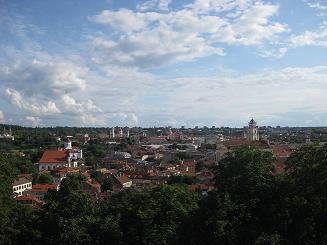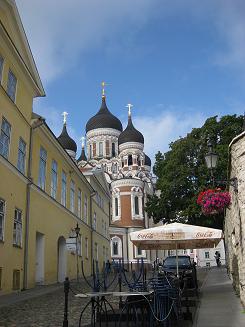Baltic Countries: Harmony between Europe and the former Soviet Union

“Have you ever heard of Estonia? It’s a small country in Europe where I took part in an adventure work camp.” Whenever I said that, my friends asked me where it was located. Most of my friends did not know anything about the country. To tell the truth, I did not even know where it was before I went there. Not just Estonia, but the other Baltic countries are also totally foreign to Koreans. After the "Iron Curtain," came down three Baltic countries, Estonia, Lithuania, and Latvia seceded from the Soviet Union in 1991 and joined the European Union. For that reason, they are the countries where both Soviets and Europeans exist side by side. Those things sparked my wanderlust.

Navel of Europe, Lithuania
This year is really meaningful for Lithuanians. It marks Lithuania's 1,000th anniversary and its 20th anniversary as the belly button of Europe. Even though the economic crisis dealt a hard blow to Lithuania, the country was swarming with tourists from the all over the world. Vilnius, the Capital of Lithuania, was chosen as the European Capital of Culture 2009. The Old Town of Vilnius was designated as a UNESCO World Heritage Site in 1994. The Old Town is filled with diverse architecture: Roman Catholic cathedrals, Orthodox Churches, and baroque and gothic style structures. The town was the biggest in Eastern Europe. It’s gorgeous; I could not stop looking at the buildings as I walked along the ancient streets. On the first day of my trip, it was drizzling outside and I walked in the rain. Soon, the rain stopped, the sun came out and two rainbows appeared next to a church. It was really awesome, the perfect balance between architecture and nature. That was not all. There was Gediminas Tower, a symbol of Vilnius, built on a hill located in the center of the old town. I could view the whole city from the castle tower, which was really nice. The buildings roofs were almost all reddish brown. Then, I visited Trakai which was once the capital of the country. If you want to find classic beauty, I would recommend visiting the city. I was first drawn to Trakai by some pictures I had seen. I just had to see it. When I got there it surpassed all my expectations. There was a castle in a lake surrounded by the most beautiful scenery. I was speechless. It looked like the castles in fairy tales.
Foothold of the Hanseatic League, Estonia
Because of its strategic position, Estonia went through countless twists and turns to become independent from foreign influence. Tallinn, the capital of Estonia, is located at the center of the Baltic Sea region. As this city is located between Western and Northern Europe, its numerous neighbors, Germany, Denmark, Sweden, and Russia all invaded Estonia in the past. During that period, its culture and social structure were heavily influenced by other nations. Because of that, Pyotr I, a Russian Emperor who admired Western European culture, built his vacation home in Tallinn. The old town of this city has retained its original form perfectly. One of guides said that there had been no damage to the old town during the Second World War because bomber planes dropped bombs in the Baltic Sea instead of the city due to heavy fog.
When I arrived in Tallinn, it was foggy. I just unpacked my baggage in a hostel and looked around the city. Fortunately, my hostel was located near the entrance of the old town so it was easy to move around. The fog started to burn off as time went by and I soon could see the luxurious buildings and churches clearly. There were three good viewpoints in the old town from where you can take in the city’s beautiful panorama. I thought Tallinn was the perfect city for tourists. Medieval costumed merchants were selling souvenirs and local products on almost every street. While I was travelling, I noticed that people could use Wi-Fi phones everywhere in Estonia, even on the bus. Would you have guessed that people use the internet everywhere for free? It was amazing. I heard that the first worldwide internet phone, Skype, was an Estonian company. At that time, I realized Estonia was also one of the most powerful countries in the Information Technology industry.

Communing with a Foreign Culture
During my stay at the adventure work camp, I could travel to many places such as Voru, Tartu, and Narva. Narva was very impressive. This city is on the border between Estonia and Russia, so people can go to Russia on foot. A river marks the demarcation line between the two countries. Russia, on the opposite side of the river, was a stone's throw away from Narva. It reminded me of China.
There are clear differences among Baltic countries when seen from the outside. However, if you examine them closely, you will notice that each country has its own language, culture and history. This strong national identity helped them preserve their language and culture even while they were in the grip of the Soviet Union. Although I did not go to Latvia, I learned something from this experience. The real purpose of travel is communication. Meeting diverse people is the key benefit from any trip. At first, I knew a few words in the local language such as "Hello", "Thank you", "Goodbye". However, whenever I tried to speak in their language, natives were delighted beyond measure. If you go abroad, put yourself in other people’s shoes. It’s natural. How do you feel when you see foreigners trying to speak Korean? Of course, as most Lithuanians and Estonians are good at speaking English, I could communicate easily. This experience may not be enough to learn everything about a foreign country, its people and its history. Nevertheless, I would not forget my romantic adventure in the Baltic countries.
By Yong Hae-ju, Senior, Dept. of Political Science & Diplomacy

